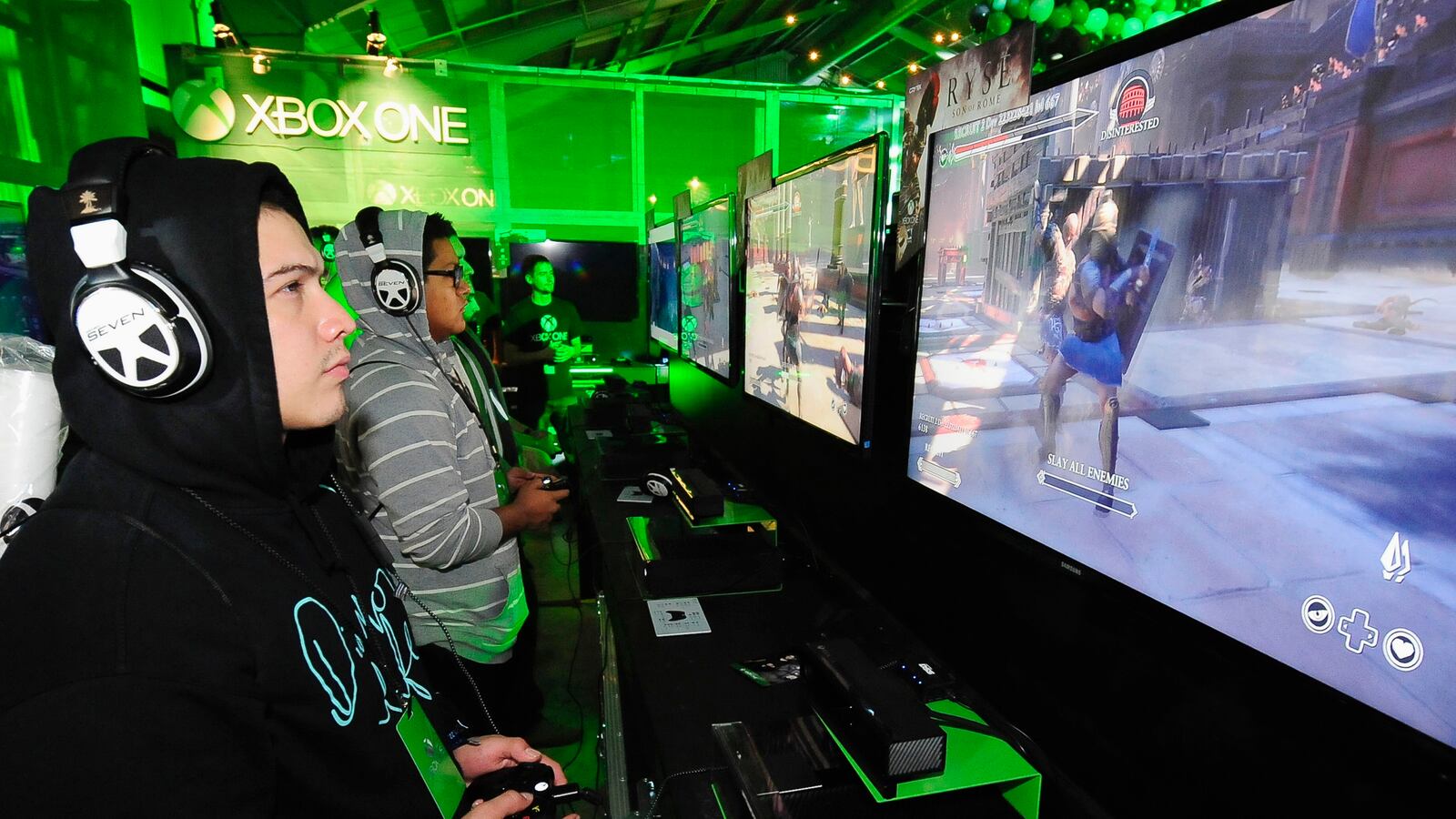You are not alone. FIFA 14 and NBA 2K14 are showing us a fascinating—and slightly disturbing—future of gaming. The Xbox One is constantly listening to what you say, specifically key words, including expletives, likely shouted at the screen after a particularly poor play. Hearing these trigger-words, the game reacts: in NBA 2K14, the player is given a technical foul; in FIFA 14, the player receives a strongly worded letter requesting that they improve their manners.

The latter is not actually a new feature (it was included in FIFA 13), but the original Kinect was an addition to the Xbox 360 rather than an integral part of the system. It was more of a silly gimmick. But this new Kinect is every bit as important to the Xbox One experience as the console itself. Although the Xbox One no longer requires the Kinect to function, it comes with every system. Games can assume that it’s there, and many already do, meaning players who don’t have one connected will miss out on features that definitely add to the experience.
You can’t really escape the Kinect; it’s a fact of being an Xbox One owner. Voice recognition isn’t perfect, so it’s not the type of thing that will work 100 percent of the time, but if there is a 1984 comparison to be made with the next-generation, it would be here: In these games, the Kinect turns a regular TV into a two-way telescreen. But unlike the telescreen, there doesn’t need to be a person watching—algorithms will suffice. And these algorithms can dictate behavior and then punish players who dismiss them. Neither FIFA 14 nor NBA 2K14 was developed by Microsoft, so they can’t be solely blamed for attempting to control behavior, but they also seem to have a problem with colorful language.
The Xbox One gives players the ability to upload clips of gameplay and record voiceover. Unfortunately, those who engage in “excessive profanity” during these uploaded videos will have some of their system-wide online privileges temporarily revoked. In a statement to Ars Technica, a Microsoft rep said that this is because “We want a clean, safe, and fun environment for all users.”
To be fair, Microsoft isn’t alone. Sony’s PlayStation 4 Eye camera may allow for many of the same features (and, in the case of FIFA 14, does), but it is purely an accessory. Most owners will never use one, and even fewer will buy one. The Wii U GamePad controller has both a front-facing camera and a microphone, and although they can be muffled, they can’t be shut off, nor can the GamePad itself. No game has ever tried to seriously utilize them, though, so it’s impossible to say how effective they are when compared to their higher-end brethren. But one can assume they’re significantly less powerful. Senior producer Rob Jones, who worked on NBA 2K13, was excited about implementing voice and facial recognition into the Wii U version of this year’s iteration, but it never saw the light of day.
This always-listening, Big Brother/behavior changing tech could be used for good, though. Rather than punishing players simply for profanity in uploaded videos, why not punish players who actively and adversely affect other players’ enjoyment? These are the people whose behaviors are seriously flawed, people who could be righted with a little in-game punishment.
Imagine that a player uses foul language, needlessly hurling insults at strangers, and suddenly a pop-up appears at the bottom of the screen: “Achievement Unlocked. ‘I’m No Fun.’” Description: “Attempt to ruin everybody else’s time.” Zero gamerpoints. Or, if that’s too permanent, the player suddenly loses the ability to fire their weapon or some short-term effect that teaches offenders to watch their mouths. And turning their headset off wouldn’t necessarily help if the Kinect was still attached. At some point, it wouldn’t be worth it to keep working around the system’s rules and behavior would simply start to change if people wanted to keep playing.
In fact, there’s something like this already in the works on the Xbox One, albeit less immediate: the “Reputation” system, which is a new metric on Xbox Live that uses a crazy algorithm to put each user into one of three categories: “Good player,” “Needs improvement,” and “Avoid me.” This long-term system both punishes poor behavior and rewards good behavior, which is key here. Riot Games, creators of the massively successful game League of Legends, which currently has over 32 million active players every day, created a system where players reported for toxic behavior are put to a tribunal made of staff members and community. Participating in this tribunal rewards players while cutting down on negativity. Explaining decisions to offenders changes player behavior (much like what both FIFA and NBA do).
But where is the line? Few people would have a serious problem with anyone being punished for using racial and homophobic slurs—but then what? Should players ever be punished for saying “fuck”? Even if the word isn’t used in polite company and the MPAA has decided that young ears will be violated by hearing it more than once, its use is widespread and not so reviled among the video game masses. Even in multiplayer games, there is no real reason to restrict it. In single player games, it’s just silly. Makes for good YouTube entertainment, sure, but it doesn’t actually make a game more real.
***
Where the Kinect becomes much more impressive and quite a lot creepier than its counterparts is its ability to track basically everything about the body’s physical state. Watch this demo, given to Wired back in May, which demonstrates how the new Kinect tracks skeletons, rotation, and force (all of which seem totally natural for it to have), plus heart rate and mood. Fusing a combination of its color and infrared sensors, it can track a person’s heart rate through their face, using “micro-fluctuations in the blood underneath their skin.” How terrifying does that sound? It’s the realization of the never-released Vitality Sensor that Nintendo introduced back in 2009. It’s used currently in Microsoft’s Xbox Fitness software, but has other interesting applications, like tracking physical response to stimuli in horror games.
The Kinect also has the ability to track basic facial expressions, which has the potential to be extremely useful. For the first time ever, a videogame console can tell if players are getting bored. (The Kinect can track multiple people at a time.) According to that demonstration, it tracks simple expressions, engagement, where the player is looking, whether they talk, if their mouth has moved, whether their mouth is open or closed, if they have glasses, and whether their eyes are open or closed. That’s a lot of information, especially when combined with everything else the camera sees. This could have some really cool implications for dynamic gameplay. In a game like Left 4 Dead, where events are triggered by artificial intelligence rather than specific developer design, this information could be translated into an even more tailored interaction-feedback loop (as could the heart rate monitor).
It could also simply be used for logging information, letting developers know what parts of their games people were most visibly engaged in or put off by. Developers already get metrics such as average playtime and can extrapolate, for example, that if 70 percent of players stop at the same puzzle, maybe it is too hard. This goes far beyond, removing some of that guesswork and in aggregate (because no individual data will be traceable to one person, which for obvious reasons Microsoft felt compelled to clarify), it could give developers a clearer picture of emotional reactions players have to their games than anything that has come before, especially since it even works in the dark.
Microsoft has made clear that even though skeletal data may be collected “to improve the gaming experience,” it is put together as a series of numbers representing distance between joints. That information won’t be traced to anybody and it will be destroyed after analysis, so users shouldn’t worry that their movements are being explicitly singled out by people in a data center only lit by walls of monitors. Users, however, should have no expectation of privacy with regards to speech, except when using Skype.
But few things attempt to change behavior more than advertising, and Microsoft has both filed for camera-related patents and spoken before about using the Kinect for advertising purposes. This could be a future where ads not only know if you’re watching them, but whether you look engaged, if you’re talking to somebody, and even what you’re talking about.
So be careful what you say and what you do, because the Kinect, for better and worse, really is [expletive] watching you.






